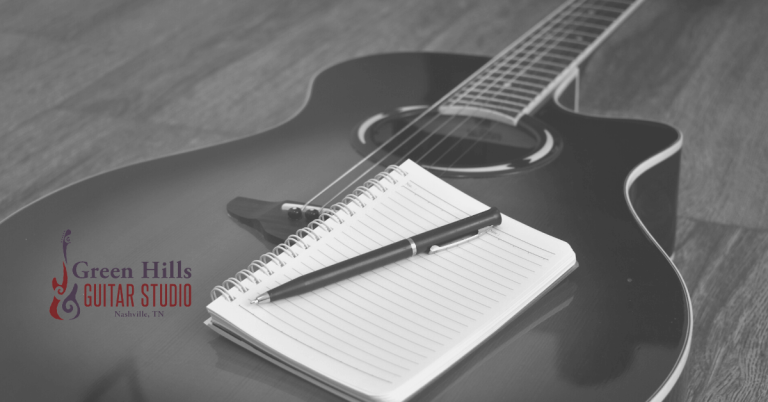Lyric Writing for Guitarists: Turning Chords into Stories
Many guitarists begin by learning riffs, scales, and chord progressions, but when it comes time to write songs, the lyrics feel like the hardest part. Chords can come quickly under your fingers, yet words often seem distant or out of reach. The truth is that lyric writing is a skill, just like learning the fretboard or practicing rhythm. With the right approach, any guitarist can turn their chords into meaningful stories.
In this guide, we will walk through lyric writing tips that are especially useful for guitar players. Whether you are brand new to songwriting or looking to strengthen your voice as a writer, these tools will help you connect your music and your words.
Why Guitarists Struggle With Lyrics
Guitarists often focus on the physical and harmonic side of music first. This can leave lyrics feeling disconnected or secondary. Common challenges include:
- Overthinking words and losing spontaneity.
- Getting stuck on rhymes instead of focusing on meaning.
- Separating chords and lyrics, treating them as unrelated instead of complementary.
- Writing only from one perspective, which can limit emotional range.
The good news is that writing lyrics works best when connected directly to your instrument. Your guitar can guide rhythm, phrasing, and mood while your words provide the story.
Step 1: Start With a Chord Progression
A simple chord progression is often the spark for a lyric idea. The harmony creates an emotional backdrop that suggests a theme or story. For example:
- A minor progression might inspire reflective or melancholic lyrics.
- A bright major progression may call for hopeful or energetic themes.
Instead of forcing words onto paper, let your chord loop play and hum melodies. Write down any phrases or single words that naturally fit with the music. This keeps your lyrics grounded in sound and emotion.
Step 2: Find Your Song’s Core Idea
Every strong lyric has a central theme or hook. Ask yourself:
- What emotion do I feel when I play these chords?
- What story do I want to tell?
- Can I sum up the song’s idea in one line?
This “song sentence” can later become your chorus or lyrical anchor. For beginners in songwriting, clarity is more powerful than complexity.
Step 3: Use Rhythm to Shape Words
Guitarists have a natural advantage: you already think rhythmically.
Use your strumming or picking pattern to shape the pacing of your words. Short, punchy strums often suit conversational lyrics, while long, ringing chords can support slower, more emotional lines.
Matching syllables to the natural groove of your playing ensures that your lyrics and guitar feel unified.
Step 4: Write in Images, Not Explanations
Great lyrics show rather than tell. Instead of saying “I was sad,” write the image that captures sadness: “The coffee’s gone cold on the table.” Listeners connect more strongly with pictures than with direct statements.
A good exercise: write three visual snapshots that describe the emotion you want. Then try weaving them into verses.
Step 5: Use the Guitar to Build Contrast
Your guitar gives you dynamic tools that can enhance lyrical meaning. For example:
- Move from open chords to higher voicings in the chorus to lift the energy.
- Switch from fingerpicking to strumming when the lyric shifts in intensity.
- Change keys or use a borrowed chord to underline a turning point in the story.
This interplay between harmony and lyric makes your song more compelling.
Step 6: Edit Without Losing Feel
Many beginner songwriters struggle with editing. They either avoid it, leaving clunky lines, or overdo it, removing the raw energy. The key is to refine for clarity while keeping the emotional spark.
- Sing every line with your guitar before changing it.
- Cut extra words that do not add meaning.
- Read your lyrics without music to make sure they stand as poetry on their own.
Common Lyric Pitfalls for Guitarists
- Relying on clichés instead of personal language.
- Using too many filler syllables that do not match rhythm.
- Ignoring phrasing, so the words feel forced on the chords.
- Writing verses that wander without returning to a central hook.
Being aware of these habits makes it easier to avoid them.
Example Exercise: Turning Chords Into Lyrics
- Choose a simple progression, like G–D–Em–C.
- Play it on repeat and hum nonsense syllables.
- Notice if a phrase emerges naturally. Write it down.
- Build your verses around that phrase.
- Shape your strumming or picking to match the feel of the lyric.
This exercise keeps the process grounded in sound rather than theory, which is especially useful for beginners.
Final Thoughts
Writing lyrics as a guitarist is not about separating music and words, but about merging them into one expression.
By starting with your instrument, shaping words around rhythm, and focusing on imagery, you can transform simple chord progressions into full songs.
At Green Hills Guitar Studio, we help students learn the mechanics of guitar and grow as creative musicians.
Whether you want guidance in lyric writing, connecting your guitar playing with your voice, or songwriting lessons, we can help you turn your ideas into finished songs.
Ready to start writing songs of your own?
Book a lesson with Green Hills Guitar Studio and learn how to connect your guitar playing with lyric writing today.







